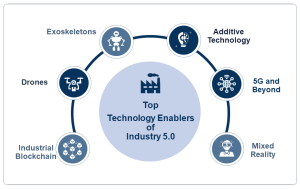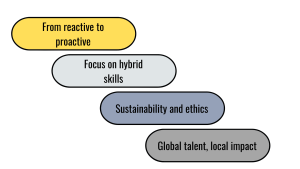Evolution of Team Augmentation in a Post-Industry 5.0 World
Introduction The world is changing rapidly. Industry 5.0 is no longer just a concept – it is becoming a reality. This new industrial era emphasizes collaboration between peopl...

Introduction
The world is changing rapidly. Industry 5.0 is no longer just a concept – it is becoming a reality. This new industrial era emphasizes collaboration between people and advanced technologies, fostering innovation and sustainability. In this context, the practice of team augmentation has undergone a significant transformation. Let’s explore how team augmentation in a Post-Industry 5.0 is evolving and why it matters.
What Defines Industry 5.0?
To understand the changes, we must first define Industry 5.0. Unlike its predecessor, Industry 4.0, which focused on automation and data sharing, Industry 5.0 prioritises human-centric innovation. It combines the power of artificial intelligence (AI), machine learning (ML), and robotics with human creativity. Sustainability and resilience are also key pillars of this era. This shift is affecting how companies build, manage, and scale their teams.

Traditional Role of Team Augmentation
In the past, it was easy to scale up a team. Companies used it to quickly fill skills gaps. It was primarily a cost-effective solution to meet short-term needs. Companies sought out outside experts to meet project deadlines or solve niche problems. While this approach was effective, it was often reactive. It was rarely aligned with a long-term strategy.
How Industry 5.0 is Changing Team Augmentation
Industry 5.0 is setting new priorities. Collaboration between humans and machines is now essential. As a result, the team must adapt to support this synergy. Let’s take a look at the main changes:
1. From reactive to proactive
In a post-Industry 5.0 world, companies can no longer afford to react to problems. Instead, they need forward-looking strategies. Augmented teams are now seen as long-term partners. They help companies anticipate trends and build resilience.
2. Focus on hybrid skills
Today, technical expertise alone is not enough. Employees must also demonstrate creativity, adaptability, and emotional intelligence. Augmented teams now include specialists who are excellent at integrating human and machine workflows. This ensures seamless collaboration and innovation.
3. Sustainability and ethics
The focus on sustainability is changing hiring practices. Companies are prioritising augmented talent that aligns with their values. Augmented teams are contributing to green practices by developing energy-efficient solutions or promoting the AI ethical use.
4. Global talent, local impact
While globalisation has always had an impact on team size, Industry 5.0 is making it even more important. Companies are increasingly leveraging global talent while focusing on creating local economic advantages. This dual approach strengthens relationships and fosters trust.

Benefits of Team Augmentation in Industry 5.0
The evolution of team augmentation brings significant benefits:
- Flexibility and agility: Augmented teams adapt quickly to change. This is extremely important in an era defined by rapid technological advancement.
- Improved collaboration: External teams bridge the gap between internal experts and new technologies.
- Cost-effectiveness: Strategic partnerships with external specialists reduce the need for ongoing hiring and training.
- Access to specialised knowledge: Companies can benefit from specialised skills that may not be available in-house.
Challenges to Overcome
Despite the promise, team augmentation in this era is not without its challenges. Businesses should address:
- Cultural integration: Teams must harmonise different work styles.
- Knowledge transfer: Effective communication ensures continuity, even with external participants.
- Security issues: As teams grow, so do the risks associated with data security and intellectual property.
Strategies for Success
To thrive in a post-Industry 5.0 world, companies need to rethink their approach:
- Invest in learning. Both internal and extended teams benefit from ongoing learning. Learning ensures alignment with new technologies and methodologies.
- Build strong relationships. Trust is essential. Regular review, clear goals, and open communication strengthen collaboration.
- Leverage technology. Tools like AI-powered project management platforms can streamline workflows. They also increase transparency across distributed teams.
- Prioritise sustainability. Augmented teams should promote green initiatives. This aligns with Industry 5.0 values and builds brand reputation.

Conclusion
The evolution of team augmentation in the post-Industry 5.0 era is just beginning. Companies that embrace this change will gain a competitive advantage. They will innovate faster, build stronger teams, and create long-term value. Ultimately, the future belongs to those who view team augmentation as a strategic asset, not just a quick fix.
Understanding these trends will help your business navigate the challenges and opportunities of this transformative era. The path forward is clear. Now is the time to build smarter, more connected teams and pave the way for a brighter, more collaborative future.